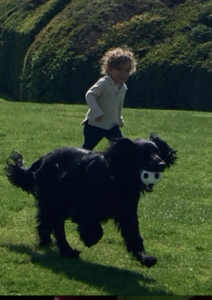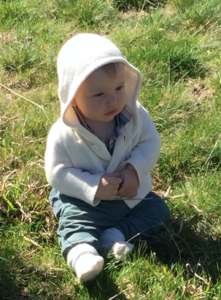What is essence? –
Essence is the real part of one and is often compared to a child within. While it is childlike, it is not childish. Young children have this state. Essence includes our type and center of gravity. Ouspensky says it includes the structure and capacities of the lower centers, while the contents of the lower centers are personality. Usually essence does not need words. Words belong to personality.

Child playing fetch with dog
Personality is formed from cultural programming as well as from imitation of our parents and people we had contact with as children. It continues to grow as we grow older.
If you haven’t read it recently, I recommend the “strawberry jam” story in In Search of the Miraculous, pages 251 to 253. It gives a clear picture of the relationship of essence to personality. It also demonstrates that essence can have different stages of development.
Personally, I did not really understand this idea from reading it. Even from what I heard in the school, it wasn’t clear. Once, after working hard physically outdoors with other students–and I am not a muscular person but a thin intellectual type–I found myself in a simple and light place inside. Personality, all that I thought and believed I was, had temporarily fallen away. This was essence.
How do we distinguish essence from personality?
Essence refers to a quality of openness that, at the beginning, we can have for only moments at a time. The real can only grow from something real. Real ‘I’ can only grow from essence, not from personality.
Our evolution depends on what happens to our essence in the course of life. People who live in the country, far from cities, are often closer to essence. Modern culture and the Internet favor personality at the expense of essence. In extreme cases, there exist “dead” people whose personality covers them completely. These people have no chance of development. Indeed, I have met a few in my various employments over the years.
Essence is the part of us that can appreciate simple beauty, such as sunlight falling through a window, a beautiful spring day, the quiet of a forest. When personality grows strong, simple pleasures pass by unnoticed.
The energy of essence
Yet another way of distinguishing personality and essence is by the quality of energy. The energy of essence is World 24, or the world of nature. Personality is World 48, the energy of the earth, while false personality has more the energy of World 96, the moon. The energy of World 24 is a light and fresh energy. If our inner world is heavy, we can sense personality manifesting.
When one remembers one’s self for a few seconds, false personality temporarily disappears and the impressions we take in go right into us. From this point of view, we don’t really need to work on developing essence; we just need to practice self-remembering.
How does essence manifest in daily life?
This lighter state appears only in flashes. The main thing is to get a clear taste of it. And this is not so simple because we live mostly in personality. Personality ridicules lighter states, just like older children ridicule younger ones. Rilke mentions “the wise incomprehension of a child.”
Babies have this state naturally. Young babies’ eyes cannot focus; their brain and nervous system are working overtime to process the flood of impressions from the five senses. There is an awareness of the present moment, without words.

Baby in nature
Think of the contrast between the baby and a crowded Manhattan sidewalk. Meanwhile, in the city, everyone dreams their thoughts, with only a marginal awareness of the present.
Returning to awareness of our surroundings
When I step out the office into the world of natural light, fresh air, and trees, a simple inner state emerges. Then I fall back into the stream of ‘I’s. Upon waking from sleep or from anesthesia, there’s a moment where one doesn’t know where or who one is. However, the normal flow of ‘I’s quickly comes and displaces this state.
Walking in a park or forest, we find moments where we are simply aware of our surroundings. A friend who goes backpacking in the high Sierra Nevada said that after a few days up there, one has almost no ‘I’s. Likewise, yoga or meditation can give this state by the end of a session. Being aware of our immediate surroundings in the present moment comes in a simple wordless way, as for a child.
David Tuttle operates a computer repair business and is an artisan bread baker with over 40 years in the work. He is the host of the Fourth-Way-based Facebook group Gurdjieff-Ouspensky Self-observation.
Featured painting image courtesy of Maria Billings.
